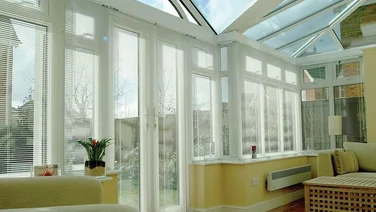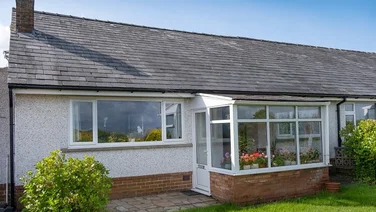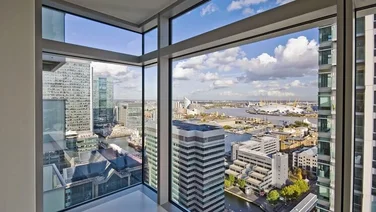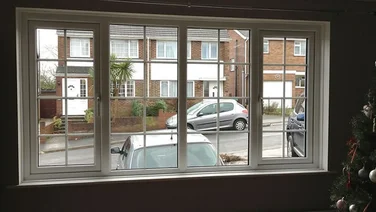✔ On average, a 1,200mm x 1,200mm sash window will cost £1,101
✔ uPVC sash windows are the cheapest option; aluminium is the most expensive
✔ Fill in the form above to receive free bespoke double glazed window quotes
Double glazed sash windows are an excellent option for homes in the UK. Though double glazed windows costs a fair amount, they lock in warmth and keep noise out.
And sash windows do this all whilst adding character to the property.
Feeling on the fence about whether to get sash windows? Take a look at our comprehensive guide below to get a better idea of what you can expect.
Once you’re ready to invest in some new windows – whether it’s for sash or any other type – it’s time to start looking for the best deals.
You can compare the best double glazing on the market by popping a few details about your home in our easy-to-use quote tool. We’ll pass on your details to our expert suppliers, who’ll get in touch with you with free quotes for you to compare.
What type of double glazing do you need?
Get started
What’s on this page?
What are double glazed sash windows?
Sash windows are pretty common in the UK, and appear on all sorts of properties – from countryside cottages to city town-houses, Edwardian homes to Victorian terraced properties.
Unlike casement windows – the most popular type of window in the UK – sash windows don’t open on a hinge. Instead, sash windows are made up of two glass panes that slide up and down (or sometimes side to side).
These panes fit into vertical grooves, placed one in front of the other, and are counterbalanced by lead weights on cords. Placing the window panes in these grooves means that sash windows can be opened at the top or bottom – or both.
How much do double glazed sash windows cost?
On average, a 1,200mm x 1,200mm sash window costs around £720 (not including VAT or installation). However, this will depend on the size of the window and the type of material you choose for the frame.
Find out more about double glazing costs with our detailed guide.
Or, to get a rough idea of how much sash windows will cost you, we’ve compared the average price of uPVC sash windows to uPVC casement windows (the cheapest option on the market) in the table below.
If you want to see whether you can get double glazing grants to help subsidise the costs, check out our guide.
One way you can cut back on costs is to install the double glazing yourself, but we wouldn’t recommend this – you could end up damaging your property and even injuring yourself.
| Dimensions of window (mm) | Casement uPVC window | Sash uPVC window |
|---|---|---|
| 600 x 900 | £290 | £580 |
| 1,200 x 1,200 | £375 | £720 |
| 1,200 x 1,800 | £540 | £935 |
Figures from Get a Window, 2022
However, bear in mind that there’s no one-size-fits-all approach to windows – the final price tag will depend on a number of features.
The type of window you go for will have the biggest impact on price. Luckily, sash windows are on the cheaper side of the spectrum, though not as cheap as casement windows.
The material you choose will also impact the price of your sash windows – with uPVC costing much less than wood or aluminium, as we’ve outlined in the table below.
| Material of sash window | Average cost per window (including materials, installation, and VAT) |
|---|---|
| uPVC | £700–£1,100 |
| Wooden | £1,100–£1,900 |
| Aluminium | £1,200–£1,500 |
Figures from Get A Window, 2022
Although they’re not the cheapest option, timber windows are usually pretty popular for sash windows because they match the traditional aesthetics. We’ve outlined how much it would cost to get wooden sash windows for different property types in the table below.
| Property type | Number of windows | Typical |
|---|---|---|
| One-bedroom flat | 4–6 | £6,000–£9,000 |
| Two-bedroom terrace | 5–7 | £7,500–£10,500 |
| Three-bedroom semi-detached | 7–9 | £10,500–£13,500 |
| Four-bedroom detached | 11–13 | £16,500–£19,500 |
What type of double glazing do you need?
Get startedWhat’s the best material for a sash window frame?
The best material for sash windows depends entirely on what you’re after.
uPVC, timber, and aluminium are the most common options for sash windows. Each comes with its own benefits and drawbacks – but what do they have to offer?
uPVC sash windows
uPVC, which stands for unplasticised polyvinyl chloride, is one of the most common choices for UK windows.
As it’s the cheapest window material on the market, uPVC is perfect for anyone on a budget. Its plastic frame is also very durable – meaning it will be low maintenance.
However, if eco-friendliness is one of your priorities, uPVC might not be for you. This strong material is made predominantly of plastic, which is created by one of the worst fossil fuels in the world: oil.
Wooden sash windows
Timber is a very popular choice for sash windows, mainly because it matches traditional aesthetics.
Although wooden sash windows are a little more on the expensive side, you certainly get what you pay for. Not only does timber look great – especially on listed buildings – but it’s also a naturally insulating material and will keep out the cold during winter.
If you live in a particularly old listed building, you might also want to opt for wooden Georgian windows, to keep the façade as similar to the original as possible.
Wooden windows are also much more eco-friendly than uPVC and aluminium windows. If this is on your list of priorities, you can also make sure to get wooden windows that have been responsibly sourced and accredited by the Forestry Stewardship Council (FSC).
However, one of the drawbacks of timber frames is that they’re more susceptible to rot and mould – but you can easily avoid this by getting the wood laminated, or by treating it every 2-3 years.
Aluminium sash windows
Aluminium sash windows are strong, durable, and highly resistant to rust and corrosion.
These windows are great for minimalistic spaces, as they often have a larger glass area and less visible frame. Most window suppliers also offer aluminium in a range of colours too.
As for quality? Aluminium window frames have high thermal insulation rates, which means they’re great at sealing in that much-needed heat. Aluminium is also a durable metal, meaning the windows are low maintenance and are built to last decades.
Aluminium window frames also help with home security, as it’s much harder to break compared to timber.
If you want to install windows with the planet in mind, you’ll be glad to know that aluminium is very sustainable, especially if the supplier offers recycled aluminium.
However, all of these advantages come at a cost – with aluminium being the most expensive window material on the market.

Advantages and disadvantages of double glazed sash windows
Pros of sash windows
Aesthetically pleasing
Sash windows have a certain elegance to them, making them perfect for anyone with a traditional property.
In fact, sash windows’ charm is typically the main reason people opt for them. Whether you go for uPVC, timber, or aluminium, they are stylistically in-keeping within a traditional property.
Can add value to your home
Although sash windows are more expensive than casement windows, they could make you money in the long run.
In some cases, having sash windows can instantly add value to your property when you come to sell. In fact, experts claim that installing double glazed sash windows will not only add value; it will also make a property more ‘sellable’.
Perfect for homes in conservation areas
If you live in a conservation area or a listed building, you might find it difficult to make any home improvements. Planning officers are super vigilant when it comes to preserving character in conservation properties and listed buildings, which means a lot of window installation requests get denied.
Thankfully, that’s not the case with sash windows. Double glazed sash windows are perfect for these traditional buildings – they keep you warm without compromising the charm of the property.
Increased ventilation
Unlike casement windows, sash windows have sliding panes that can help ventilate the room.
Having two sliding sashes means you can create an opening at the bottom and the top of the window, which allows you to engineer a cooling convection flow – ideal for the summer. The lack of hinges also means you don’t have to worry about a gust of wind slamming the window shut.
Cons of sash windows
More expensive than casement
One of the main drawbacks to sash windows is their price tag.
Although they’re not the most expensive windows out there, they’re pricier than casement windows. Typically, a 1,200mm x 1,200mm uPVC sash window will set you back £720, whilst the same sized casement window will only cost £375 – almost half the amount.
More maintenance
As with any product with moving parts, sash windows can experience more wear and tear compared to other types of windows. This is because the window panes need to slide over each other to open or close, which can lead to worn out frameworks and peeling paintwork.
Can be heavy
Depending on the size of the panes, sash windows can be quite heavy to open and close. For most people, this shouldn’t be an issue. However, for older people or anyone with mobility issues, the bulkiness of sash windows might cause some issues.
| Pros | Cons |
|---|---|
| Aesthetically pleasing | Expensive |
| Can add value to your home | More maintenance |
| Perfect for homes in conservation areas | Can be heavy |
| Increased ventilation |
Should you get double glazed sash windows?
If the aesthetics of the window is your top priority, sash windows are a good option – not to mention they add value to your property.
However, if you’re more concerned about the affordability of your new windows, it might be worth considering casement windows instead, since they’re a bit cheaper.
Most homes in the UK are suitable for sash windows – just make sure to double check before installing any windows if you live in a listed building or a conservation area.
Next steps
Hopefully you have a better idea of whether sash windows are the best option for your home now.
Once you’re feeling happy with your decision – whether you settle on sash windows or not – it’s time to compare quotes to make sure you get the best deal. Luckily, we can help with that too.
All you have to do is pop a few details about your home in our easy-to-use quote tool. We’ll pass on your details to our expert suppliers, who’ll get in touch with you with free quotes for you to compare.





